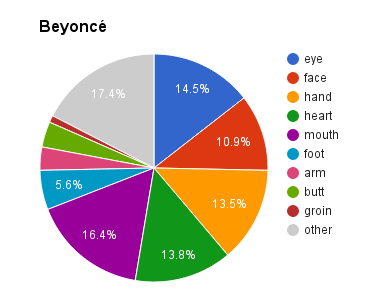
Body Language
How Pop Musicians Sing About The Body
After analyzing the lyrics of various pop music artists for mentions of body parts, this song and visualization was constructed by sampling the most frequently sung body parts by each artist. The goal is to sonify and visualize how the body has been represented in popular music over time.
The Song
Listen to the song by using the player above, or check out the song on Soundcloud if you prefer no visuals or would like to comment on a specific part of the song. Read further down to learn more about how the song was constructed.
Composition
The song composition is entirely algorithmic and is composed of the following building blocks:
-
12 pop music artists that I chose based on the following criteria:
- Popularity: Sold 75 million records or more
- Output / Volume: Released at least five LPs
- Acclaim: Earned at least five Grammy Awards
Additionally, I tried to pick a variety of artists in terms of gender, genre, and musical era. The 12 artists are: The Beatles, Diana Ross, Michael Jackson, Madonna, Green Day, Mariah Carey, Jay Z, Beyoncé, Eminem, Rihanna, Kanye West, Taylor Swift
- The lyrical content of the artists' entire bodies of work. Read more below for how I obtained these lyrics.
- A list of body parts that I used to analyze the lyrical content of each artist.
- The top three body parts mentioned for each artist was used to construct the final song.
- The more an artist mentioned a particular body part in their body of work, the more that body part was used in the resulting song. The lyrical frequency of body parts are highlighted in the visualization as well.
- I sample actual mentions of body parts from each artist so the listener also gets an idea of how the artists sing about body parts in addition to what those body parts are.
The Data & Prior Work
This piece was largely inspired by Flesh Map: Listen, a visualization of the use of words representing body parts in popular culture created by Fernanda Viégas and Martin Wattenberg.
Where Viégas and Wattenberg analyze a comprehensive sampling of 10,000 songs, I focus on only 12 music artists' bodies of work. My rationale was that I wanted to make a song that was sonically pleasing and use the actual words sung by the artists themselves. I thought this would not only give the listener an idea of which body parts are most sung, but gives a feeling of how they are sung. As a result, there were some obstacles: obtaining these sound samples manually is time-consuming, and obtaining them automatically is technically challenging. Additionally, too many artists, sounds, and words would be overwhelming for the listener, so I (somewhat arbitrarily) limited my scope to 12 artists.
I obtained the lyrics by scraping the popular lyrics database and website genius.com. Then I searched the lyrics for occurences of body parts. Some words such as "behind" or "back" needed to be excluded since they are ambiguous. Also, words that refer to the same area of the body were treated the same (e.g. butt, buttocks, ass, booty, etc).
Each words was scored based on the frequency they are mentioned compared to all other mentions of body parts. Here's some samplings of the results:
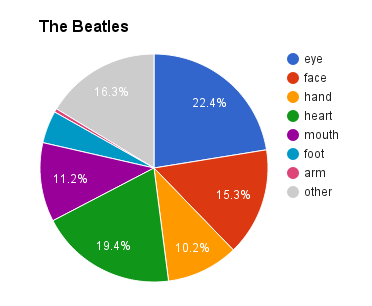

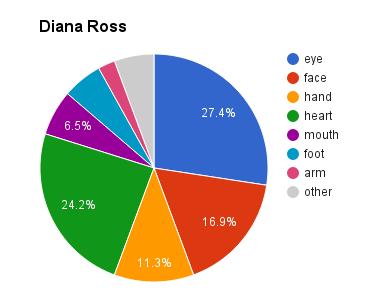
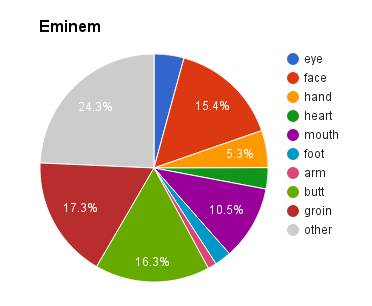
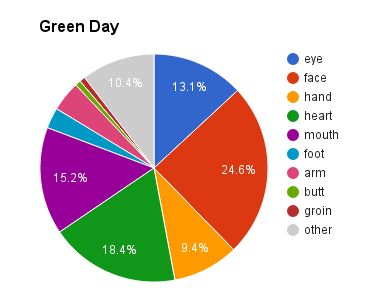


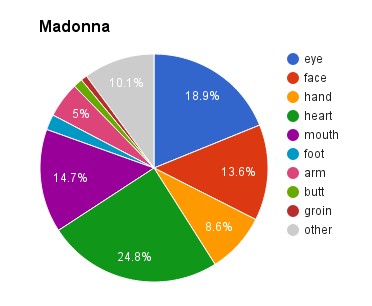
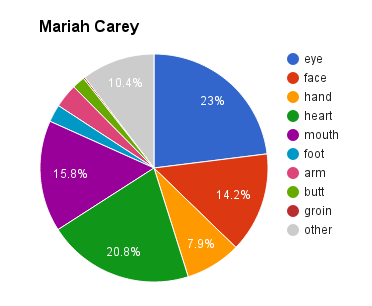
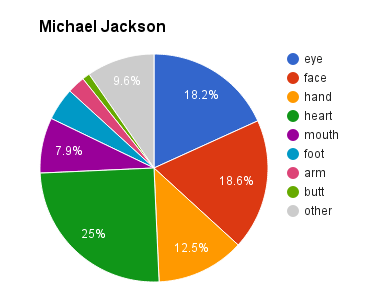
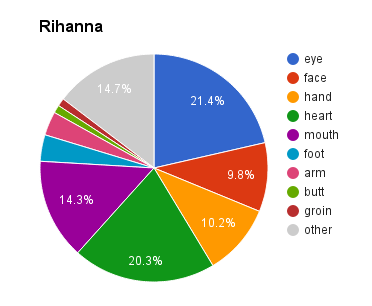
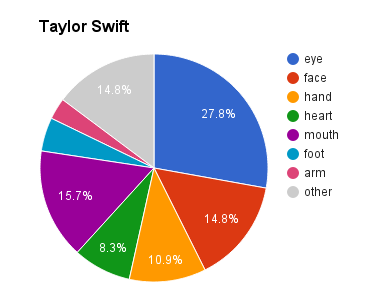
Style & Sounds Used
The entire song is composed exclusively of 170 samples from the music artists that the data represents. These sounds were obtained in various ways, but mostly by scouring Youtube and the internet. Here is a sample of sounds used in this song:
- The Beatles: Eleanor Rigby (e.g. ), Here Comes The Sun (e.g. ), Lovely Rita (e.g. ), Lucy In The Sky With Diamonds (e.g. ), Sgt. Pepper's Lonely Hearts Club Band (e.g. )
- Diana Ross: Endless Love (e.g. ), I'm Coming Out (e.g. ), I'm Still Waiting (e.g. ), Reflections (e.g. ), Someday We'll Be Together (e.g. )
- Michael Jackson: Beat It (e.g. ), Billie Jean (e.g. ), Thriller (e.g. )
- Madonna: Bad Girl (e.g. ), Frozen (e.g. ), Like A Prayer (e.g. )
- Green Day: Brain Stew (e.g. ), Geek Stink Breath (e.g. ), Homecoming (e.g. )
- Mariah Carey: Butterfly (e.g. ), My All (e.g. ), Touch My Body (e.g. ), We Belong Together (e.g. )
- Jay Z: All I Need (e.g. ), Dirt Off Your Shoulder (e.g. ), Hola' Hovito (e.g. ), Lucifer (e.g. ), Moment of Clarity (e.g. ), Never Change (e.g. ), Threat (e.g. )
- Beyoncé: Countdown (e.g. ), Ego (e.g. ), Love On Top (e.g. ), Partition (e.g. ), Rocket (e.g. ), XO (e.g. )
- Eminem: Ass Like That (e.g. ), Drips (e.g. ), My Name Is (e.g. )
- Rihanna: California King Bed (e.g. ), Diamonds (e.g. ), Russian Roulette (e.g. ), Umbrella (e.g. ), We Found Love (e.g. )
- Kanye West: Diamonds from Sierra Leone (e.g. ), Get Em High (e.g. ), Jesus Walks (e.g. ), Runaway (e.g. )
- Taylor Swift: Blank Space (e.g. ), Forever & Always (e.g. ), Invisible (e.g. ), Teardrops on my Guitar (e.g. ), White Horse (e.g. ), Wildest Dreams (e.g. )
Tools & Process
This song was algorithmically generated in that I wrote a computer program that took data and music samples as input and generated the song as output. I did not manually compose any part of this song.
For those interested in replicating, adapting, or extending my process, all of the code and sound files is open source and can be found here. It also contains a comprehensive README to guide you through the setup and configuration. The following is a brief outline of my process:
- I decided upon 12 music artists.
- I scraped all the lyrics of those artists from genius.com.
- I analyzed the lyrics based on mentions of body parts.
- I extracted individual samples from songs by the artists. I created a script to help me identify which songs had the most mentions of relevant body parts.
-
I wrote a script that:
- Assigned samples to each artist based on the body-word frequencies determined in the previous steps.
- Generated a sequence of sounds based on the sample assignments of the previous step.
- The sequence of sounds from the previous step was fed into ChucK, a programming language for real-time sound synthesis and music creation. I used ChucK because it is really good at generating strongly-timed sequences. The output would then be an audio file that I could listen to.
- I then repeated the previous steps numerous times, tweaking the sounds and the algorithms until I was satisfied with the result
- I used Processing to generate the visualization using the data above.
If you happen to use my code and create something new, please shoot me an email at hello@brianfoo.com. I'd love to see and share your work!
Questions & Feedback
I'd love to hear from you. I'm sure I've also made some erroneous statements somewhere, so please correct me. You can use the widget below or email me at hello@brianfoo.com.
Data-Driven DJ is a series of music experiments that combine data, algorithms, and borrowed sounds.
My goal is to explore new experiences around data consumption beyond the written and visual forms by taking advantage of music's temporal nature and capacity to alter one's mood. Topics will range from social and cultural to health and environmental.
Each song will be made out in the open: the creative process will be documented and published online, and all custom software written will be open-source. Stealing, extending, and remixing are inevitable, welcome, and encouraged. Check out the FAQs for more information.
About me
 My name is Brian Foo and I am a programmer and visual artist living and working in New York City. Learn more about what I do on my personal website. You can also follow my work on Twitter, Facebook, Soundcloud, or Vimeo.
My name is Brian Foo and I am a programmer and visual artist living and working in New York City. Learn more about what I do on my personal website. You can also follow my work on Twitter, Facebook, Soundcloud, or Vimeo.